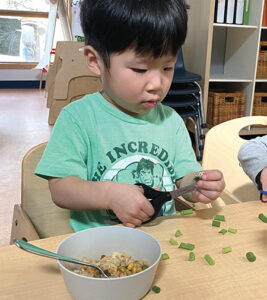“The snack table is open” is called across the classroom to the delight of busy children who leap up from play and head to wash hands in preparation for snack time.
We have had many iterations of snacks and snack time routines over the years. We left the routine of everyone eating snack at a prescribed time to a more open format many years ago as it aligned with our belief that children are competent to know when they are hungry and ready to stop playing and eat. We similarly evaluated our food offerings and long ago opted to do our best to shop local and organic products and be mindful of the nutritional value of what we were serving. It’s been a fruit and veggie strong menu and also a predictable menu with a two-week rotation which streamlined our grocery order and offered predictability to parents.
In other words, we thought we were doing pretty well in snack time department in our 12 child care programs. We had a check mark next to the care routine of snack time.
Until an educator asked a question that stopped us in our tracks and decisively unchecked the snack time box.
She asked “Why is our snack menu so western and unreflective of the cultures the children represented?”

Rolling dough for dumplings. [©Society of Richmond Children’s Centres]
And so, began our journey to decolonize our snack menu.
We did what we always do in times of misalignment. We reflected on our values and we had conversations with our educators, families and the children. We listened first and then we made thoughtful intentional changes. What were snacks we could easily offer that would mean something to the children who are predominantly of Asian heritage? What other offerings could our very diverse staff team make?
What has emerged is a snack menu that is reflective of our children, families and educators.
What has delighted us with joy is the reaction of the children and the educators. When we added a broad category of bread to the snack rotation our educators stepped up to make bread that reflected their culture. We had bannock, naan, roti, flatbread, garlic bread. And each one came with a story, a rich story, of the educator’s history and culture, of their families and cooking with beloved parents and grandparents. The children delighted in familiar and new smells and tastes. The same happened on dumpling day, gyoza, soup dumplings, perogies … snack is a feast and delight now, a vehicle for sharing and connecting…. For building relationships … which is, after all, the absolute core value of our work. Sharing an onion pancake or a piece of bannock with your friends became a way to share history, and family, and be seen and heard.
ADVERTISEMENT

Cutting green onions for fried rice. [©Society of Richmond Children’s Centres]
We went from snack being a rote chore to it reflecting the core of the kind of community we seek to be – diverse, inclusive, innovative. We have all learned to make rice balls and love bulgogi alongside the old staples of yogurt and cheese and crackers. We hear stories from the children “My mom makes these at home. I help her” to “I didn’t know there were dumplings like this!” to “THIS is bread? Wow.” Children are no longer passively being offered snack – they are often the creators and directors of it’s making, offering us all they know about their connection to food and culture and showing us their deep pride in their culture as well as their curiosity about other cultures.
This experience has us casting our eyes and thinking around what other aspects of our daily care routines need this kind of re-thinking, re-imagining, as we continuously seek to be an organization that learns and grows in service of the children and families in our community in Richmond BC Canada.
This Karen Stephens quote from Carol Garboden Murray’s seminal work “Illuminating Care” sums up our experience. “The part we play in providing sustenance is dovetailed with promoting social and cultural attachments. Feeding children is one of the most fundamental ways child care supports the family specifically and the community in general. It’s an awesome privilege, but also an intimidating responsibility.”
Related
ADVERTISEMENT













